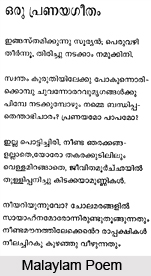 Malayalam literature over the centuries has developed a tradition which, even while rooted in the locality, is truly universal in taste. It is remarkably free from the provincialisms and parochial prejudices that have bedevilled the literature of certain other areas. To its basic Dravidian stock have been added elements borrowed or adopted from non-Dravidian literatures such as Sanskrit, Arabic, French, Portuguese and English. The earliest of these associations was inevitably with Tamil language. Sanskrit, however, accounts for the largest of the foreign influences, followed closely in recent times by English. This broad based cosmopolitanism has indeed become a distinctive feature of Malayalam literature.
Malayalam literature over the centuries has developed a tradition which, even while rooted in the locality, is truly universal in taste. It is remarkably free from the provincialisms and parochial prejudices that have bedevilled the literature of certain other areas. To its basic Dravidian stock have been added elements borrowed or adopted from non-Dravidian literatures such as Sanskrit, Arabic, French, Portuguese and English. The earliest of these associations was inevitably with Tamil language. Sanskrit, however, accounts for the largest of the foreign influences, followed closely in recent times by English. This broad based cosmopolitanism has indeed become a distinctive feature of Malayalam literature.
History of Malayalam Literature
According to historical evidences, Malayalam literature is at least a thousand years old. A comprehensive literary history of Kerala should take into account the works produced in the region not only in Malayalam language, but also in Tamil, beginning with the fourth century B.C. and continuing to the end of the first millennium A.D. The early period of Malayalam literature comprised mainly three phases namely Pacha-Malayalam stream, Tamil stream and Sanskrit stream.
Influences on Malayalam Literature
The three streams (Pacha-Malayalam stream, Tamil stream and Sanskrit stream) were influencing each other in a complementary manner. Even Sanskrit language and literature had an overriding and forever influence on Malayalam literature at large. Lilatilakam is the earliest recorded book, dealing with particular aspects of Malayalam grammar, dedicating most of its space to the grammar and rhetoric of Manipravala compositions. Such compositions fall under two principal literary forms, namely - Sandesha Kavyas and Champus. Amongst the many Sandesha (message) poems in Malayalam literature, the most outstanding is Unnunili Sandesam, whose authorship however remains unknown.
Authors in Malayalam Literature
Malayalam literature includes the names of several noble authors, whose fields range from prose, verses, poetries, and more. Works of Ezhuthachan include Adhyatma Ramayanam, Bharatham and Bhagavatham and these are considered as greatest classics in Malayalam language. Kilippattu is the name given to the form of verse he has made popular. The Pattu of the Kili signifies `parrot song` and his Ramayana and Mahabharata are still regarded as great Bhakti poems in the said language. Till around 18th century, Kilippattu, Champu and Sandeshakavya compositions had been produced by many a poet in Kerala. The Attakkatha and Tullal compositions have enriched Malayalam verse in a significant and considerable way. Attakatha is the literature form used for the well-known Kathakali dance performance. Ramanattam by Kottarakara Tampuran is the first ever full-fledged Attakatha (referring to autobiography).
Malayalam literature can evidently claim to possess a fairly prolonged history of prose writings. Poets and scholars like Kerala Varma and Rajaraja Varma had paved the way for an abiding and enduring renaissance in Malayalam literature. Chandu Menon`s social novels and C.V. Raman Pillai`s historical novels are unanimously deemed outstanding classics in literature in the Malayalam language. The contribution of the great-trio Kumaranasan, Vallathol Narayana Menon and Ullor S. Parameswara Iyer, has profoundly and intensely enriched Malayalam literature by their writings in verse and prose. This has been, since long years announced the golden period in modern Malayalam poetry.
Some of the leading Malayali poets of the 19th and 20th centuries comprise Venamani Nambudiripad, Kerala Varma, Kottarattil Sankunni, K.C. Kesava Pillai, K. K. Raja and N. Balamaniyamma. The important translational works of this period include Valiya Koyil Tampuran`s Shakuntala (1881), Kunnikkuttan Tampuran`s Hamlet and Mahabharata and Vallattol Narayana Menon`s Ramayana (1878). Later there alighted upon the scenario poets like G. Sankara Kurup, who won the first Gyanpith Award and Changapuzha Krishna Pillai, Vailoppilli Sreedhara Menon, N.V. Krishna Warrier, O.N.V. Kurup, Vayalar Rama Varma.
Some of the renowned fiction writers of Malayalam literature are Kesavadev, Thakazhi, Muhammed Basheer, Ponkunnam Varki, S.K. Pottekkad, P.C. Kuttikrishnan, Daroor, Kavoor, K. Sundhareshan, Parapurathhu, and M.T. Vasudevan Nair. This list in Malayalam literature also includes playwrights like E.V. Krishna Pillai, Thoppil Bhasi, N.N. Pillai, T.N. Gopinathan Nair, K.T. Muhammad, C.J. Thomas, G. Sankara Pillai, C.N. Sreekantan Nair and critics like P.K. Narayana Pillai, Kuttikrishna Marar, M.P. Paul, Mundassery, Sukumar Azhikode, M. Govindan, S. Guptan Nair, M.Krishnan Nair, K.P. Appan and M.N. Viyanan. Some of the legendary novelists in Malayalam literature consisted of Vennayil Kunniraman Nayanar, Appan Tampuran, V. K. Kunnan Menon, Ambati Narayana Potuval and C. P. Achyuta Menon, who indeed had grounded the present day Malayalam prose style. Some poets of the modern school of Malayalam literature comprise Kumaran Ashan, G. Sankara Kurup, K. K. Raja, Channampuzha Krishna Pilla and N. Balamaniyamma.













